Копия helminthiasis- gololobova.ppt
- Количество слайдов: 63
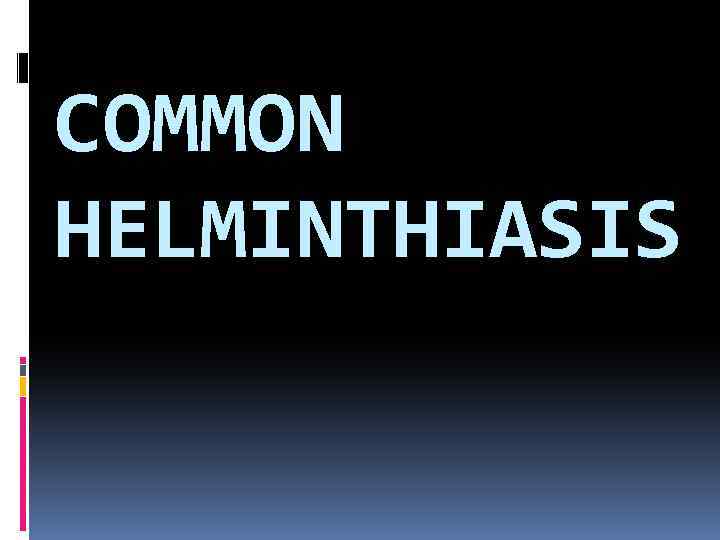 COMMON HELMINTHIASIS
COMMON HELMINTHIASIS
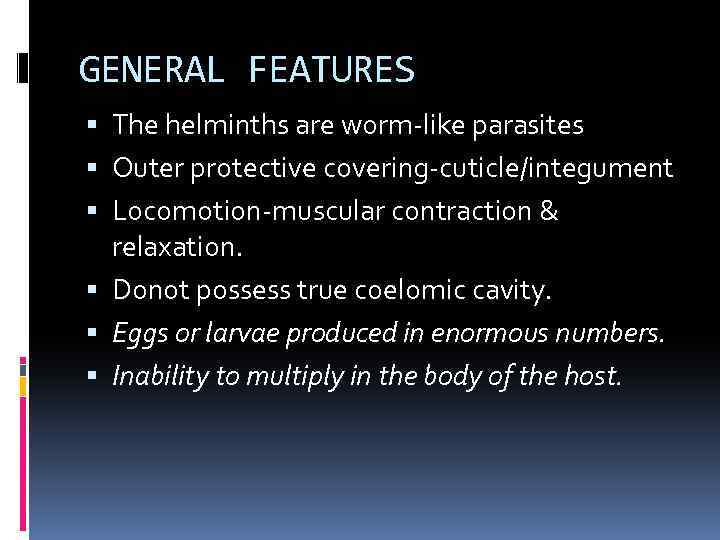 GENERAL FEATURES The helminths are worm-like parasites Outer protective covering-cuticle/integument Locomotion-muscular contraction & relaxation. Donot possess true coelomic cavity. Eggs or larvae produced in enormous numbers. Inability to multiply in the body of the host.
GENERAL FEATURES The helminths are worm-like parasites Outer protective covering-cuticle/integument Locomotion-muscular contraction & relaxation. Donot possess true coelomic cavity. Eggs or larvae produced in enormous numbers. Inability to multiply in the body of the host.
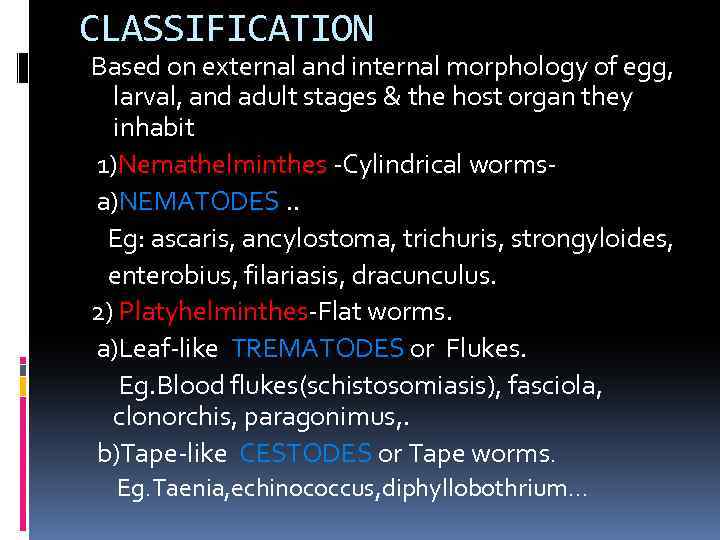 CLASSIFICATION Based on external and internal morphology of egg, larval, and adult stages & the host organ they inhabit 1)Nemathelminthes -Cylindrical worms- a)NEMATODES. . Eg: ascaris, ancylostoma, trichuris, strongyloides, enterobius, filariasis, dracunculus. 2) Platyhelminthes-Flat worms. a)Leaf-like TREMATODES or Flukes. Eg. Blood flukes(schistosomiasis), fasciola, clonorchis, paragonimus, . b)Tape-like CESTODES or Tape worms. Eg. Taenia, echinococcus, diphyllobothrium…
CLASSIFICATION Based on external and internal morphology of egg, larval, and adult stages & the host organ they inhabit 1)Nemathelminthes -Cylindrical worms- a)NEMATODES. . Eg: ascaris, ancylostoma, trichuris, strongyloides, enterobius, filariasis, dracunculus. 2) Platyhelminthes-Flat worms. a)Leaf-like TREMATODES or Flukes. Eg. Blood flukes(schistosomiasis), fasciola, clonorchis, paragonimus, . b)Tape-like CESTODES or Tape worms. Eg. Taenia, echinococcus, diphyllobothrium…
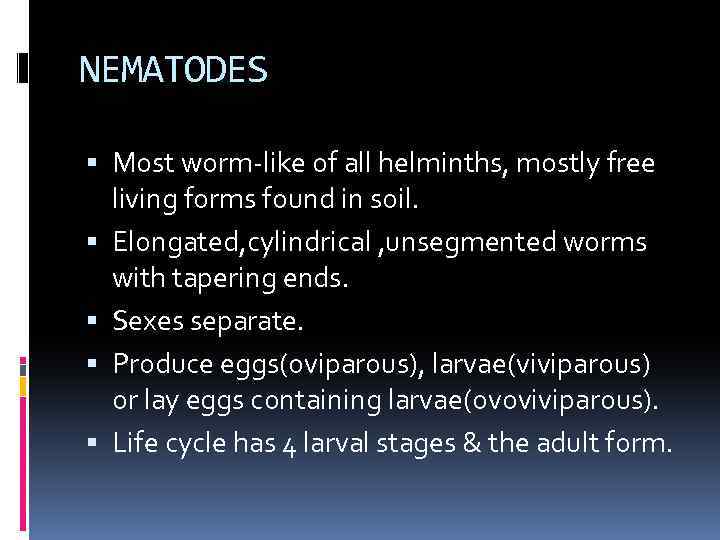 NEMATODES Most worm-like of all helminths, mostly free living forms found in soil. Elongated, cylindrical , unsegmented worms with tapering ends. Sexes separate. Produce eggs(oviparous), larvae(viviparous) or lay eggs containing larvae(ovoviviparous). Life cycle has 4 larval stages & the adult form.
NEMATODES Most worm-like of all helminths, mostly free living forms found in soil. Elongated, cylindrical , unsegmented worms with tapering ends. Sexes separate. Produce eggs(oviparous), larvae(viviparous) or lay eggs containing larvae(ovoviviparous). Life cycle has 4 larval stages & the adult form.
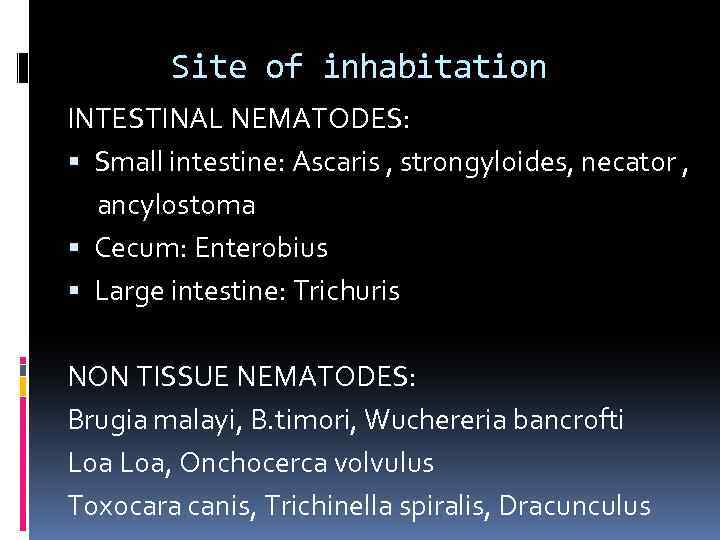 Site of inhabitation INTESTINAL NEMATODES: Small intestine: Ascaris , strongyloides, necator , ancylostoma Cecum: Enterobius Large intestine: Trichuris NON TISSUE NEMATODES: Brugia malayi, B. timori, Wuchereria bancrofti Loa, Onchocerca volvulus Toxocara canis, Trichinella spiralis, Dracunculus
Site of inhabitation INTESTINAL NEMATODES: Small intestine: Ascaris , strongyloides, necator , ancylostoma Cecum: Enterobius Large intestine: Trichuris NON TISSUE NEMATODES: Brugia malayi, B. timori, Wuchereria bancrofti Loa, Onchocerca volvulus Toxocara canis, Trichinella spiralis, Dracunculus
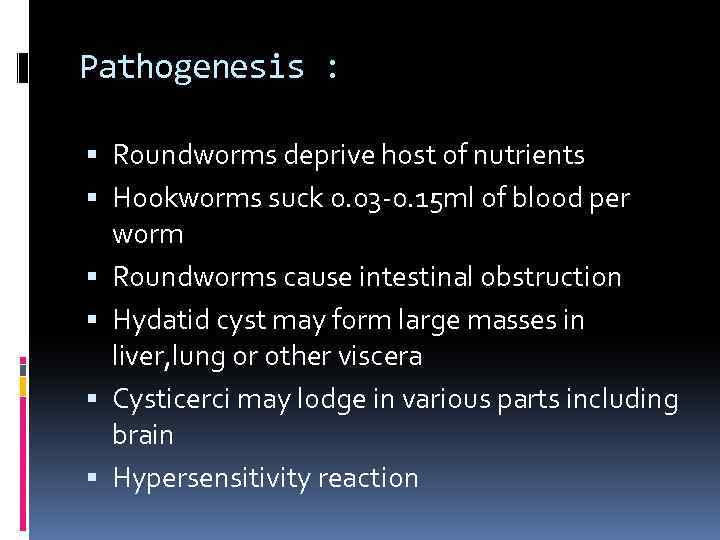 Pathogenesis : Roundworms deprive host of nutrients Hookworms suck 0. 03 -0. 15 ml of blood per worm Roundworms cause intestinal obstruction Hydatid cyst may form large masses in liver, lung or other viscera Cysticerci may lodge in various parts including brain Hypersensitivity reaction
Pathogenesis : Roundworms deprive host of nutrients Hookworms suck 0. 03 -0. 15 ml of blood per worm Roundworms cause intestinal obstruction Hydatid cyst may form large masses in liver, lung or other viscera Cysticerci may lodge in various parts including brain Hypersensitivity reaction
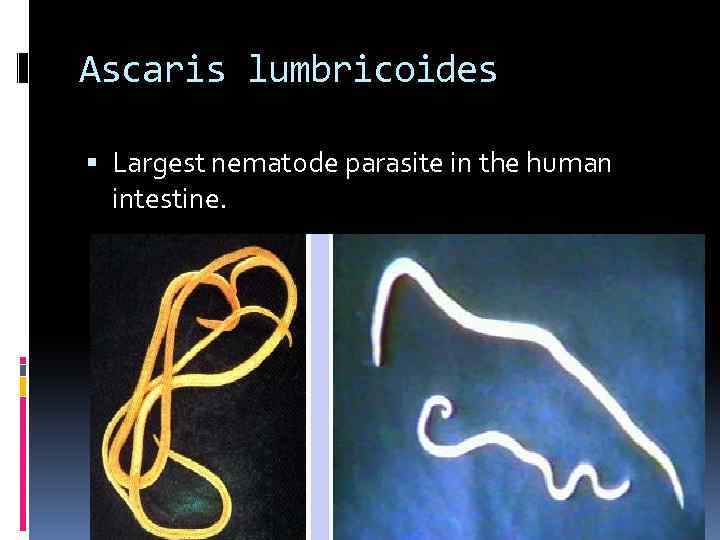 Ascaris lumbricoides Largest nematode parasite in the human intestine.
Ascaris lumbricoides Largest nematode parasite in the human intestine.
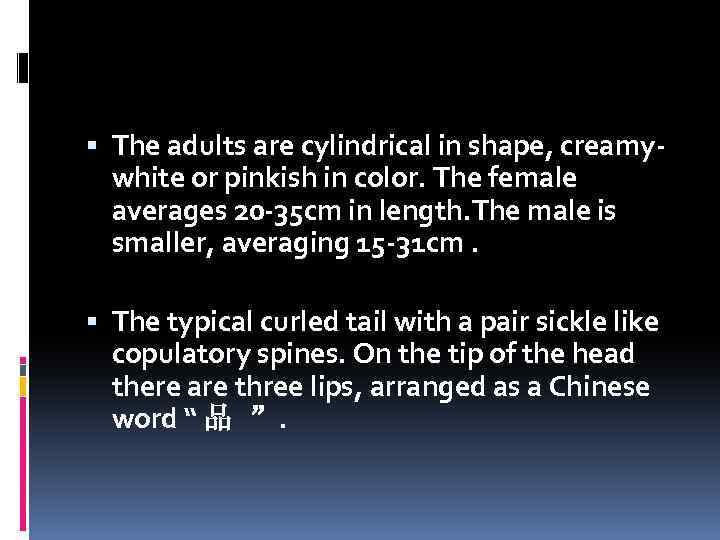 The adults are cylindrical in shape, creamywhite or pinkish in color. The female averages 20 -35 cm in length. The male is smaller, averaging 15 -31 cm. The typical curled tail with a pair sickle like copulatory spines. On the tip of the head there are three lips, arranged as a Chinese word “ 品 ”.
The adults are cylindrical in shape, creamywhite or pinkish in color. The female averages 20 -35 cm in length. The male is smaller, averaging 15 -31 cm. The typical curled tail with a pair sickle like copulatory spines. On the tip of the head there are three lips, arranged as a Chinese word “ 品 ”.
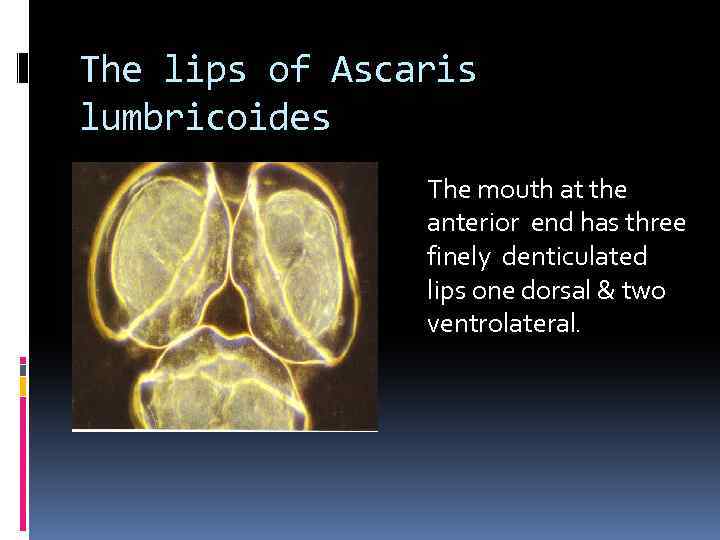 The lips of Ascaris lumbricoides The mouth at the anterior end has three finely denticulated lips one dorsal & two ventrolateral.
The lips of Ascaris lumbricoides The mouth at the anterior end has three finely denticulated lips one dorsal & two ventrolateral.
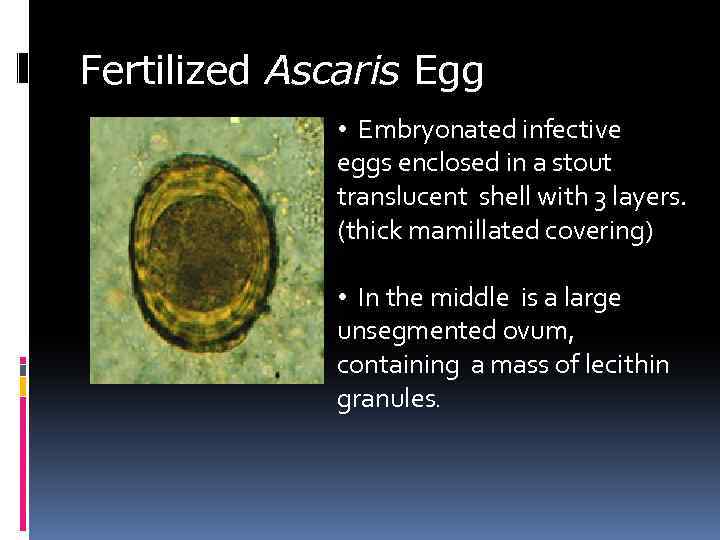 Fertilized Ascaris Egg • Embryonated infective eggs enclosed in a stout translucent shell with 3 layers. (thick mamillated covering) • In the middle is a large unsegmented ovum, containing a mass of lecithin granules.
Fertilized Ascaris Egg • Embryonated infective eggs enclosed in a stout translucent shell with 3 layers. (thick mamillated covering) • In the middle is a large unsegmented ovum, containing a mass of lecithin granules.
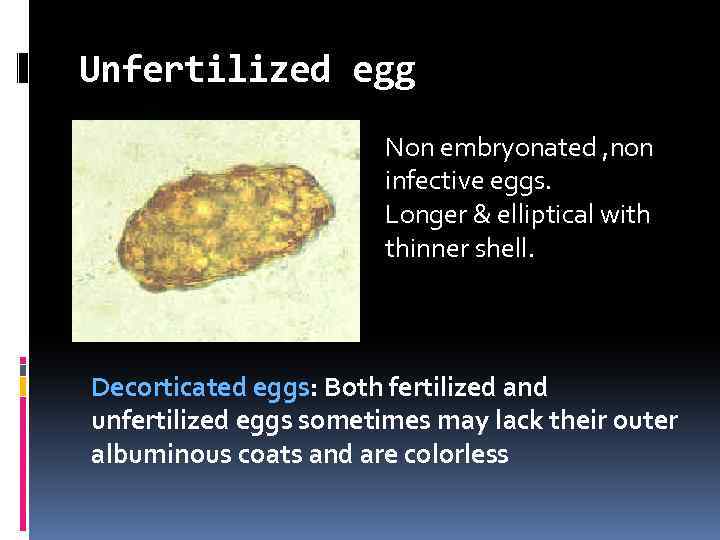 Unfertilized egg Non embryonated , non infective eggs. Longer & elliptical with thinner shell. Decorticated eggs: Both fertilized and unfertilized eggs sometimes may lack their outer albuminous coats and are colorless
Unfertilized egg Non embryonated , non infective eggs. Longer & elliptical with thinner shell. Decorticated eggs: Both fertilized and unfertilized eggs sometimes may lack their outer albuminous coats and are colorless
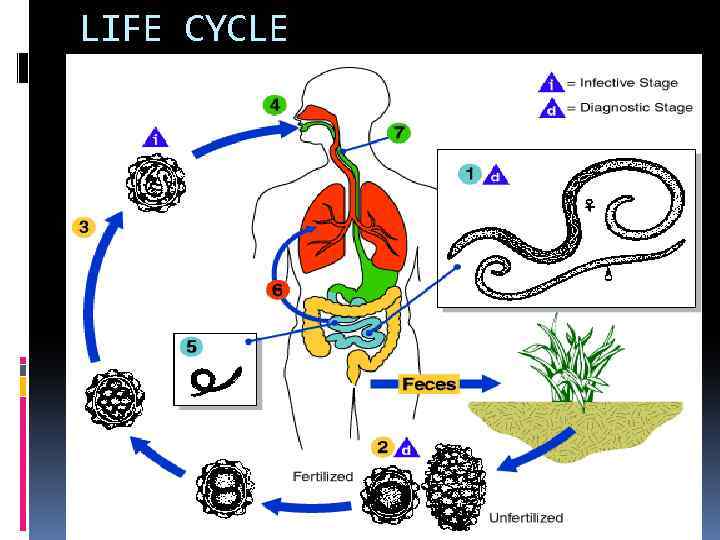 LIFE CYCLE
LIFE CYCLE
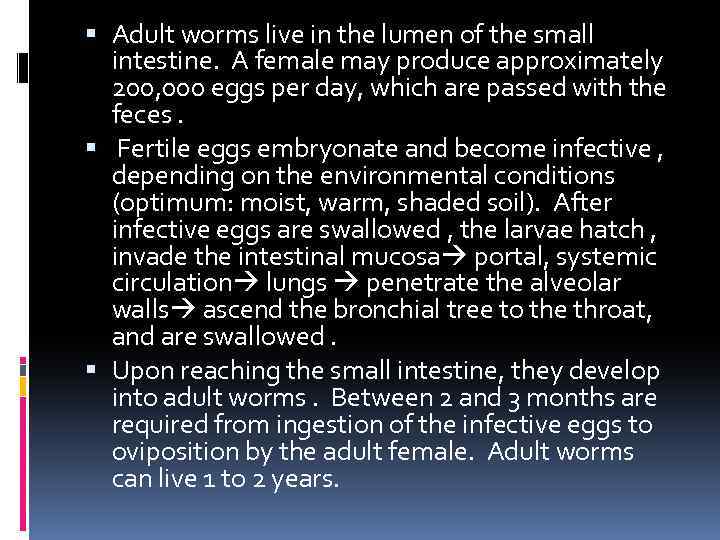 Adult worms live in the lumen of the small intestine. A female may produce approximately 200, 000 eggs per day, which are passed with the feces. Fertile eggs embryonate and become infective , depending on the environmental conditions (optimum: moist, warm, shaded soil). After infective eggs are swallowed , the larvae hatch , invade the intestinal mucosa portal, systemic circulation lungs penetrate the alveolar walls ascend the bronchial tree to the throat, and are swallowed. Upon reaching the small intestine, they develop into adult worms. Between 2 and 3 months are required from ingestion of the infective eggs to oviposition by the adult female. Adult worms can live 1 to 2 years.
Adult worms live in the lumen of the small intestine. A female may produce approximately 200, 000 eggs per day, which are passed with the feces. Fertile eggs embryonate and become infective , depending on the environmental conditions (optimum: moist, warm, shaded soil). After infective eggs are swallowed , the larvae hatch , invade the intestinal mucosa portal, systemic circulation lungs penetrate the alveolar walls ascend the bronchial tree to the throat, and are swallowed. Upon reaching the small intestine, they develop into adult worms. Between 2 and 3 months are required from ingestion of the infective eggs to oviposition by the adult female. Adult worms can live 1 to 2 years.
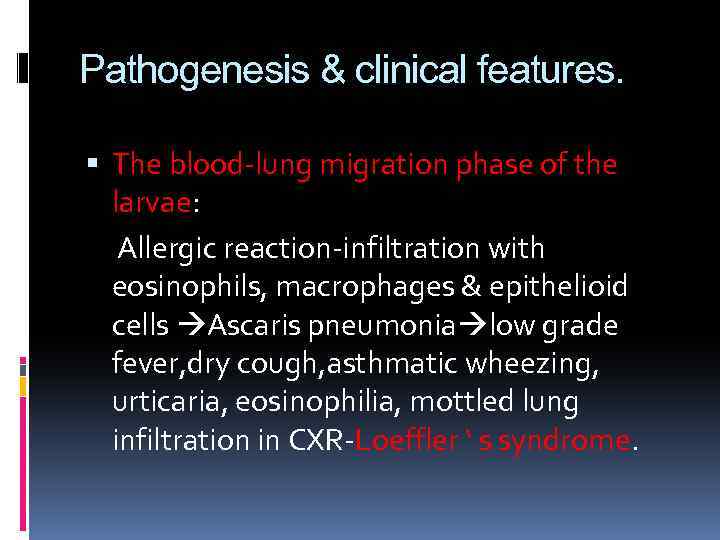 Pathogenesis & clinical features. The blood-lung migration phase of the larvae: Allergic reaction-infiltration with eosinophils, macrophages & epithelioid cells Ascaris pneumonia low grade fever, dry cough, asthmatic wheezing, urticaria, eosinophilia, mottled lung infiltration in CXR-Loeffler ‘ s syndrome.
Pathogenesis & clinical features. The blood-lung migration phase of the larvae: Allergic reaction-infiltration with eosinophils, macrophages & epithelioid cells Ascaris pneumonia low grade fever, dry cough, asthmatic wheezing, urticaria, eosinophilia, mottled lung infiltration in CXR-Loeffler ‘ s syndrome.
 The intestinal phase of the adults Usually produces no symptoms, but may give rise to vague abdominal pains or intermittent colic. A heavy worm burden can result in malnutrition. Wandering adults may block the appendical lumen or the common bile duct and perforate the intestinal wall. Thus complications of ascariasis, such as intestinal obstruction, appendicitis, biliary ascariasis, perforation of the intestine, cholecystitis, pancreatitis and peritonitis, etc. , may occur.
The intestinal phase of the adults Usually produces no symptoms, but may give rise to vague abdominal pains or intermittent colic. A heavy worm burden can result in malnutrition. Wandering adults may block the appendical lumen or the common bile duct and perforate the intestinal wall. Thus complications of ascariasis, such as intestinal obstruction, appendicitis, biliary ascariasis, perforation of the intestine, cholecystitis, pancreatitis and peritonitis, etc. , may occur.
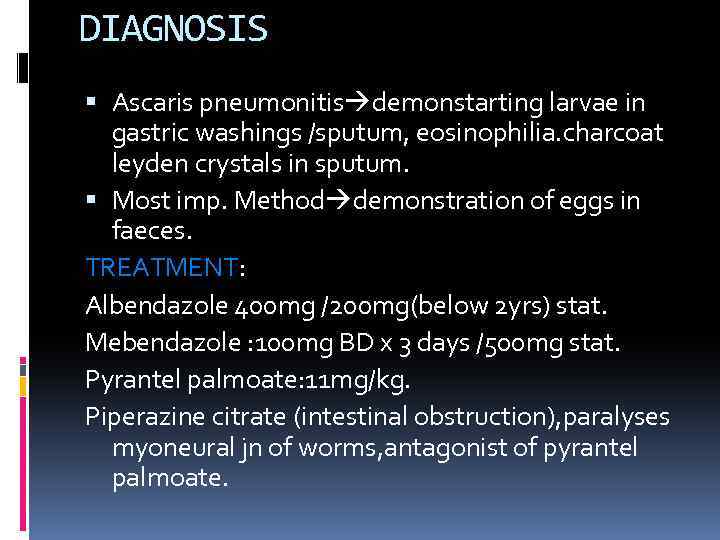 DIAGNOSIS Ascaris pneumonitis demonstarting larvae in gastric washings /sputum, eosinophilia. charcoat leyden crystals in sputum. Most imp. Method demonstration of eggs in faeces. TREATMENT: Albendazole 400 mg /200 mg(below 2 yrs) stat. Mebendazole : 100 mg BD x 3 days /500 mg stat. Pyrantel palmoate: 11 mg/kg. Piperazine citrate (intestinal obstruction), paralyses myoneural jn of worms, antagonist of pyrantel palmoate.
DIAGNOSIS Ascaris pneumonitis demonstarting larvae in gastric washings /sputum, eosinophilia. charcoat leyden crystals in sputum. Most imp. Method demonstration of eggs in faeces. TREATMENT: Albendazole 400 mg /200 mg(below 2 yrs) stat. Mebendazole : 100 mg BD x 3 days /500 mg stat. Pyrantel palmoate: 11 mg/kg. Piperazine citrate (intestinal obstruction), paralyses myoneural jn of worms, antagonist of pyrantel palmoate.
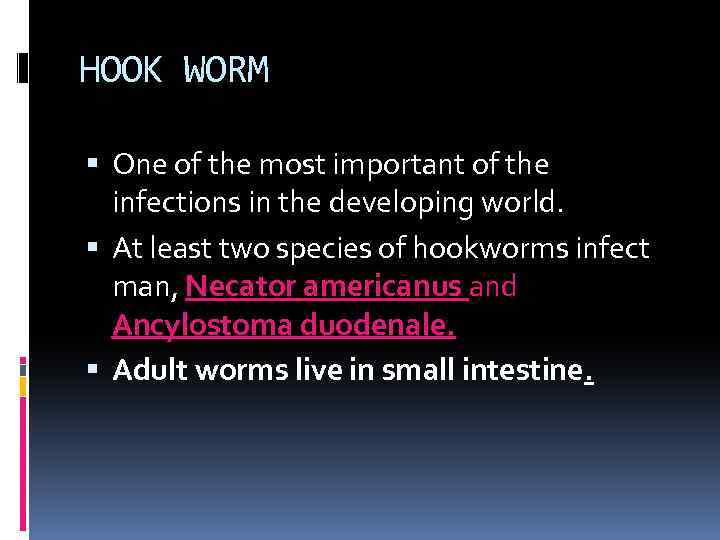 HOOK WORM One of the most important of the infections in the developing world. At least two species of hookworms infect man, Necator americanus and Ancylostoma duodenale. Adult worms live in small intestine.
HOOK WORM One of the most important of the infections in the developing world. At least two species of hookworms infect man, Necator americanus and Ancylostoma duodenale. Adult worms live in small intestine.
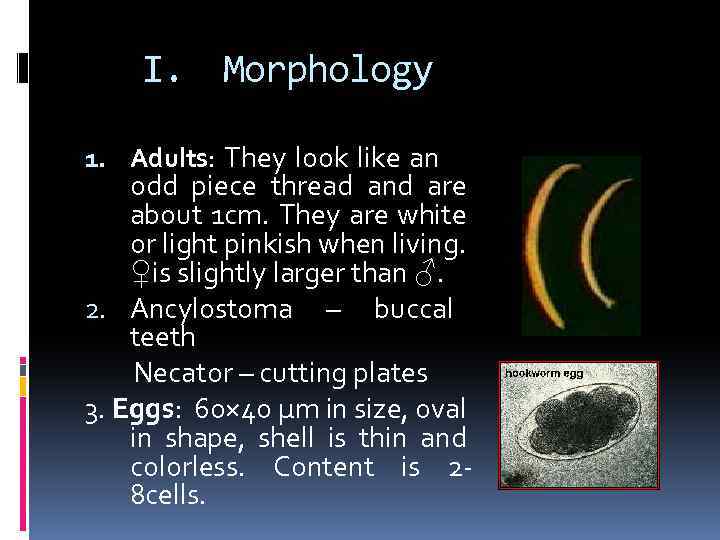 I. Morphology 1. Adults: They look like an odd piece thread and are about 1 cm. They are white or light pinkish when living. ♀is slightly larger than ♂. 2. Ancylostoma – buccal teeth Necator – cutting plates 3. Eggs: 60× 40 µm in size, oval in shape, shell is thin and colorless. Content is 28 cells.
I. Morphology 1. Adults: They look like an odd piece thread and are about 1 cm. They are white or light pinkish when living. ♀is slightly larger than ♂. 2. Ancylostoma – buccal teeth Necator – cutting plates 3. Eggs: 60× 40 µm in size, oval in shape, shell is thin and colorless. Content is 28 cells.
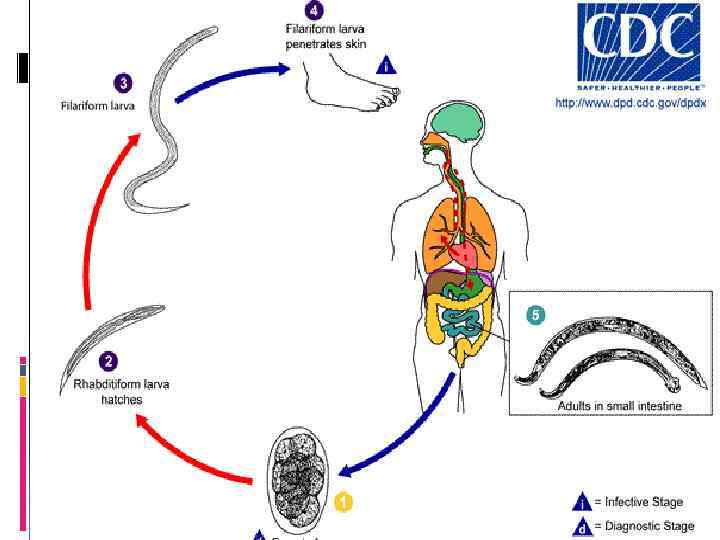
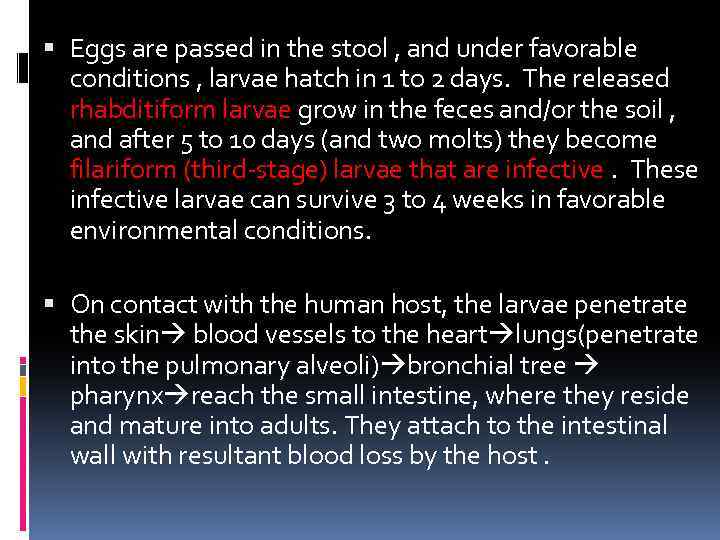 Eggs are passed in the stool , and under favorable conditions , larvae hatch in 1 to 2 days. The released rhabditiform larvae grow in the feces and/or the soil , and after 5 to 10 days (and two molts) they become filariform (third-stage) larvae that are infective. These infective larvae can survive 3 to 4 weeks in favorable environmental conditions. On contact with the human host, the larvae penetrate the skin blood vessels to the heart lungs(penetrate into the pulmonary alveoli) bronchial tree pharynx reach the small intestine, where they reside and mature into adults. They attach to the intestinal wall with resultant blood loss by the host.
Eggs are passed in the stool , and under favorable conditions , larvae hatch in 1 to 2 days. The released rhabditiform larvae grow in the feces and/or the soil , and after 5 to 10 days (and two molts) they become filariform (third-stage) larvae that are infective. These infective larvae can survive 3 to 4 weeks in favorable environmental conditions. On contact with the human host, the larvae penetrate the skin blood vessels to the heart lungs(penetrate into the pulmonary alveoli) bronchial tree pharynx reach the small intestine, where they reside and mature into adults. They attach to the intestinal wall with resultant blood loss by the host.
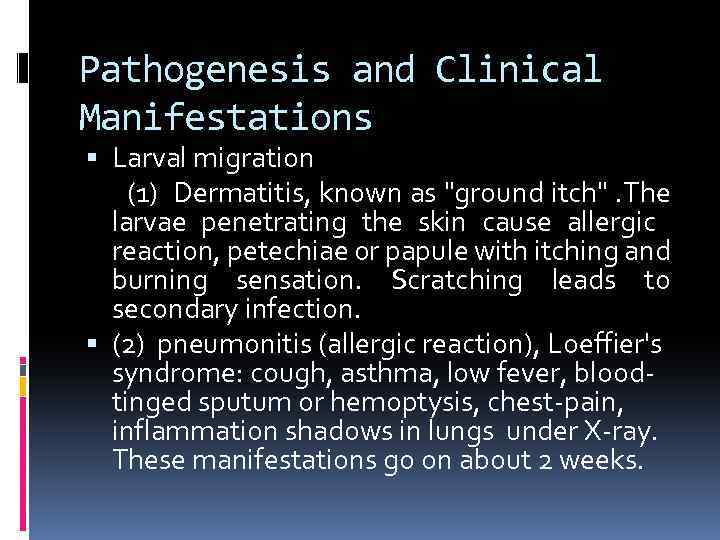 Pathogenesis and Clinical Manifestations Larval migration (1) Dermatitis, known as "ground itch". The larvae penetrating the skin cause allergic reaction, petechiae 0 r papule with itching and burning sensation. Scratching leads to secondary infection. (2) pneumonitis (allergic reaction), Loeffier's syndrome: cough, asthma, low fever, bloodtinged sputum or hemoptysis, chest-pain, inflammation shadows in lungs under X-ray. These manifestations go on about 2 weeks.
Pathogenesis and Clinical Manifestations Larval migration (1) Dermatitis, known as "ground itch". The larvae penetrating the skin cause allergic reaction, petechiae 0 r papule with itching and burning sensation. Scratching leads to secondary infection. (2) pneumonitis (allergic reaction), Loeffier's syndrome: cough, asthma, low fever, bloodtinged sputum or hemoptysis, chest-pain, inflammation shadows in lungs under X-ray. These manifestations go on about 2 weeks.
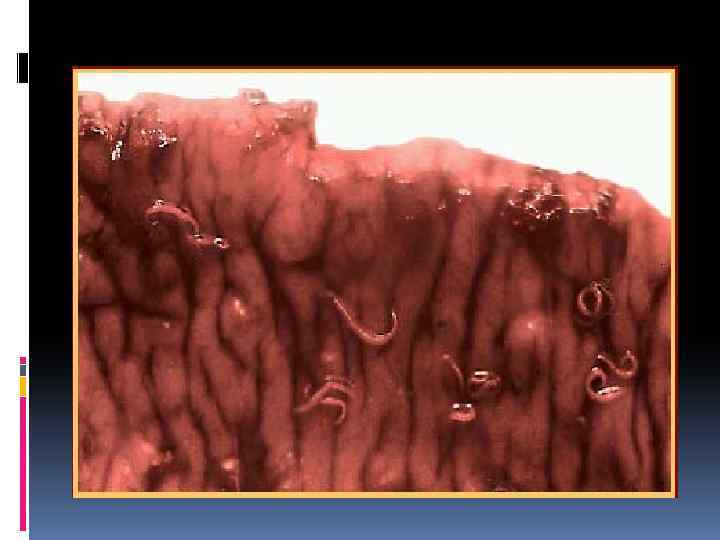
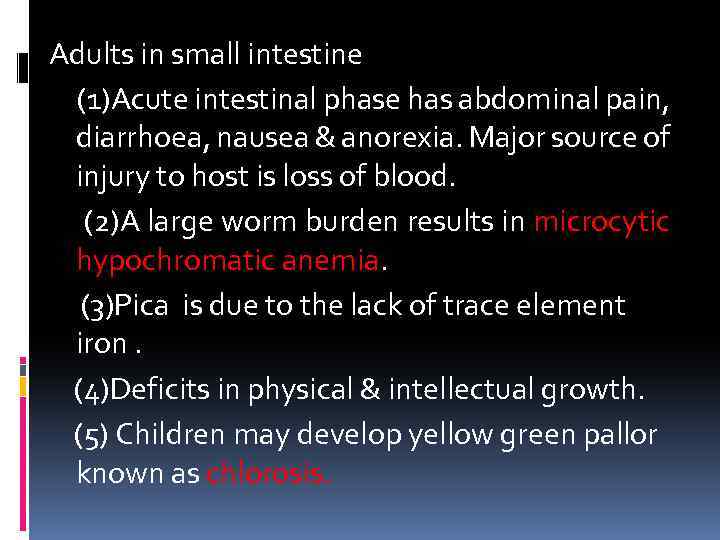 Adults in small intestine (1)Acute intestinal phase has abdominal pain, diarrhoea, nausea & anorexia. Major source of injury to host is loss of blood. (2)A large worm burden results in microcytic hypochromatic anemia. (3)Pica is due to the lack of trace element iron. (4)Deficits in physical & intellectual growth. (5) Children may develop yellow green pallor known as chlorosis.
Adults in small intestine (1)Acute intestinal phase has abdominal pain, diarrhoea, nausea & anorexia. Major source of injury to host is loss of blood. (2)A large worm burden results in microcytic hypochromatic anemia. (3)Pica is due to the lack of trace element iron. (4)Deficits in physical & intellectual growth. (5) Children may develop yellow green pallor known as chlorosis.
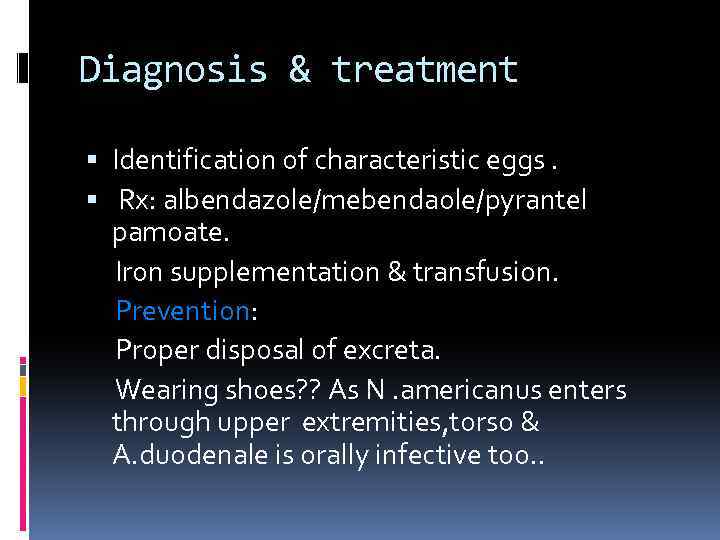 Diagnosis & treatment Identification of characteristic eggs. Rx: albendazole/mebendaole/pyrantel pamoate. Iron supplementation & transfusion. Prevention: Proper disposal of excreta. Wearing shoes? ? As N. americanus enters through upper extremities, torso & A. duodenale is orally infective too. .
Diagnosis & treatment Identification of characteristic eggs. Rx: albendazole/mebendaole/pyrantel pamoate. Iron supplementation & transfusion. Prevention: Proper disposal of excreta. Wearing shoes? ? As N. americanus enters through upper extremities, torso & A. duodenale is orally infective too. .
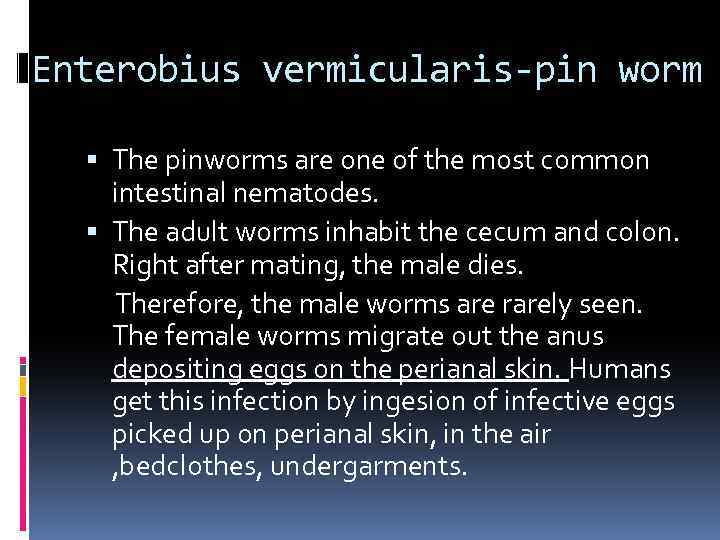 Enterobius vermicularis-pin worm The pinworms are one of the most common intestinal nematodes. The adult worms inhabit the cecum and colon. Right after mating, the male dies. Therefore, the male worms are rarely seen. The female worms migrate out the anus depositing eggs on the perianal skin. Humans get this infection by ingesion of infective eggs picked up on perianal skin, in the air , bedclothes, undergarments.
Enterobius vermicularis-pin worm The pinworms are one of the most common intestinal nematodes. The adult worms inhabit the cecum and colon. Right after mating, the male dies. Therefore, the male worms are rarely seen. The female worms migrate out the anus depositing eggs on the perianal skin. Humans get this infection by ingesion of infective eggs picked up on perianal skin, in the air , bedclothes, undergarments.
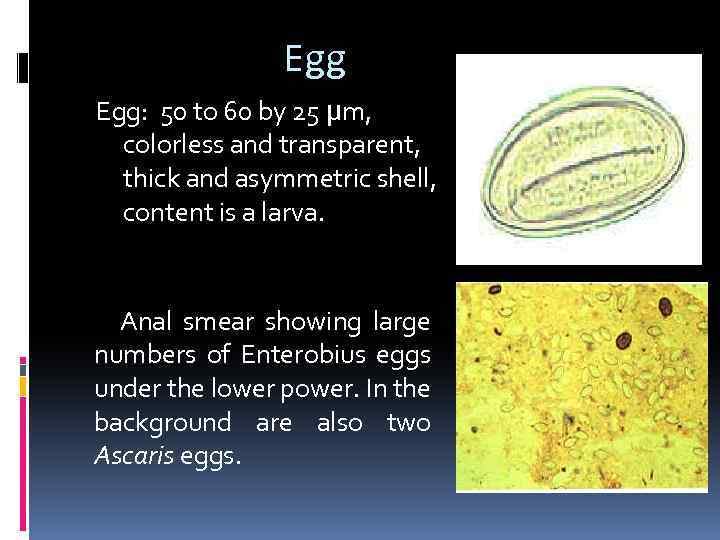 Egg Egg: 50 to 60 by 25 µm, colorless and transparent, thick and asymmetric shell, content is a larva. Anal smear showing large numbers of Enterobius eggs under the lower power. In the background are also two Ascaris eggs.
Egg Egg: 50 to 60 by 25 µm, colorless and transparent, thick and asymmetric shell, content is a larva. Anal smear showing large numbers of Enterobius eggs under the lower power. In the background are also two Ascaris eggs.
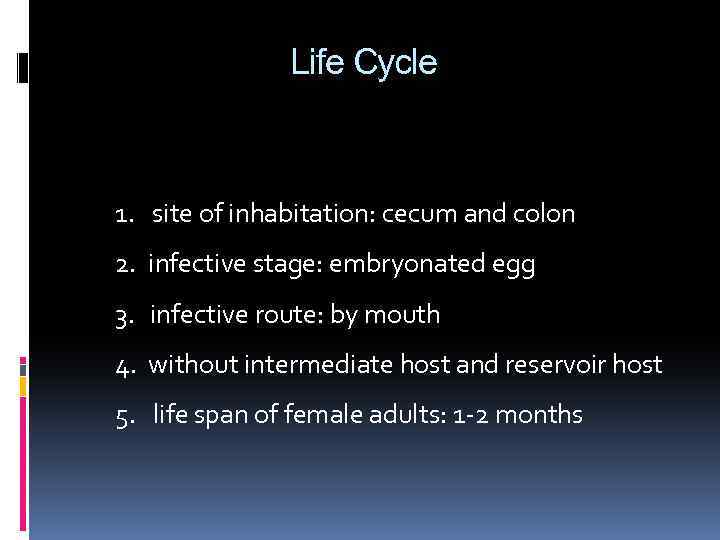 Life Cycle 1. site of inhabitation: cecum and colon 2. infective stage: embryonated egg 3. infective route: by mouth 4. without intermediate host and reservoir host 5. life span of female adults: 1 -2 months
Life Cycle 1. site of inhabitation: cecum and colon 2. infective stage: embryonated egg 3. infective route: by mouth 4. without intermediate host and reservoir host 5. life span of female adults: 1 -2 months
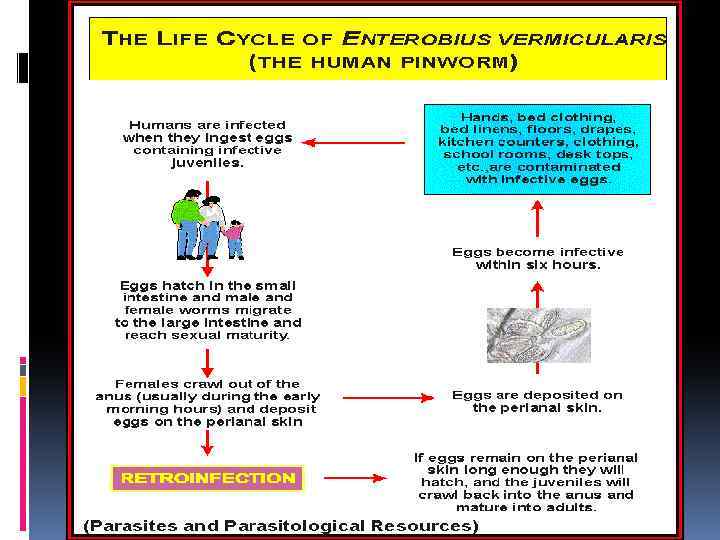
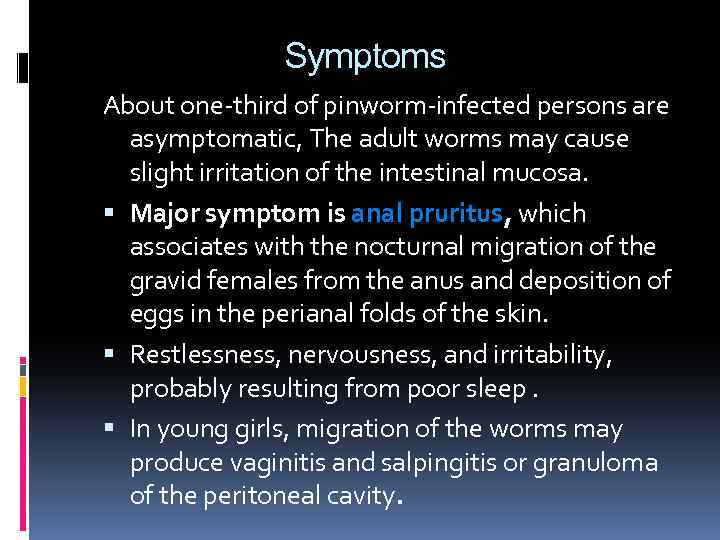 Symptoms About one-third of pinworm-infected persons are asymptomatic, The adult worms may cause slight irritation of the intestinal mucosa. Major symptom is anal pruritus, which associates with the nocturnal migration of the gravid females from the anus and deposition of eggs in the perianal folds of the skin. Restlessness, nervousness, and irritability, probably resulting from poor sleep. In young girls, migration of the worms may produce vaginitis and salpingitis or granuloma of the peritoneal cavity.
Symptoms About one-third of pinworm-infected persons are asymptomatic, The adult worms may cause slight irritation of the intestinal mucosa. Major symptom is anal pruritus, which associates with the nocturnal migration of the gravid females from the anus and deposition of eggs in the perianal folds of the skin. Restlessness, nervousness, and irritability, probably resulting from poor sleep. In young girls, migration of the worms may produce vaginitis and salpingitis or granuloma of the peritoneal cavity.
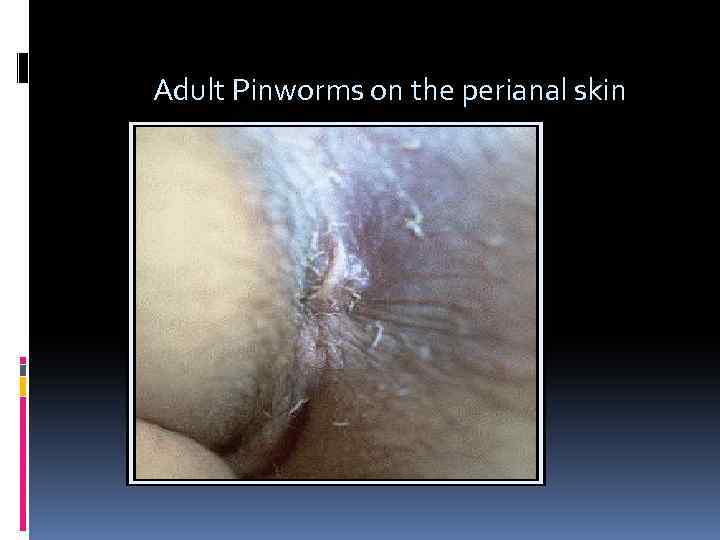 Adult Pinworms on the perianal skin
Adult Pinworms on the perianal skin
 Diagnosis depends on recovery of the characteristic eggs. The eggs and the female adults can be removed from the folds of the skin in the perianal regions by the use of the cellophane tape method. The examination should be made in the morning, before the patient has washed or defecated
Diagnosis depends on recovery of the characteristic eggs. The eggs and the female adults can be removed from the folds of the skin in the perianal regions by the use of the cellophane tape method. The examination should be made in the morning, before the patient has washed or defecated
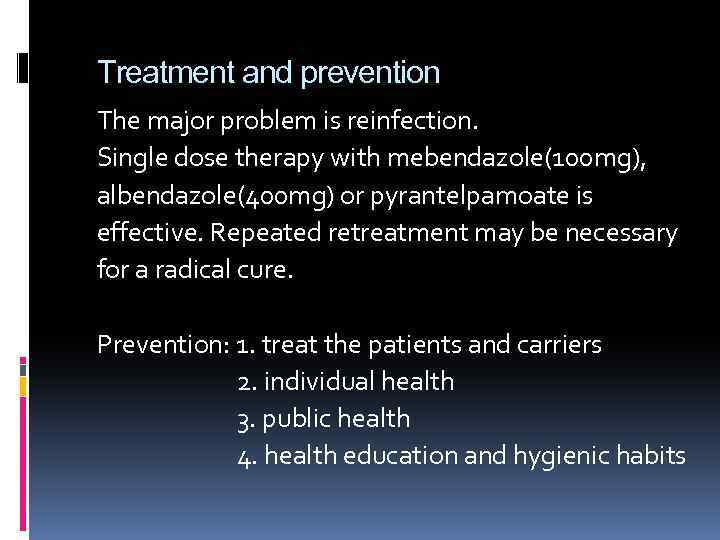 Treatment and prevention The major problem is reinfection. Single dose therapy with mebendazole(100 mg), albendazole(400 mg) or pyrantelpamoate is effective. Repeated retreatment may be necessary for a radical cure. Prevention: 1. treat the patients and carriers 2. individual health 3. public health 4. health education and hygienic habits
Treatment and prevention The major problem is reinfection. Single dose therapy with mebendazole(100 mg), albendazole(400 mg) or pyrantelpamoate is effective. Repeated retreatment may be necessary for a radical cure. Prevention: 1. treat the patients and carriers 2. individual health 3. public health 4. health education and hygienic habits
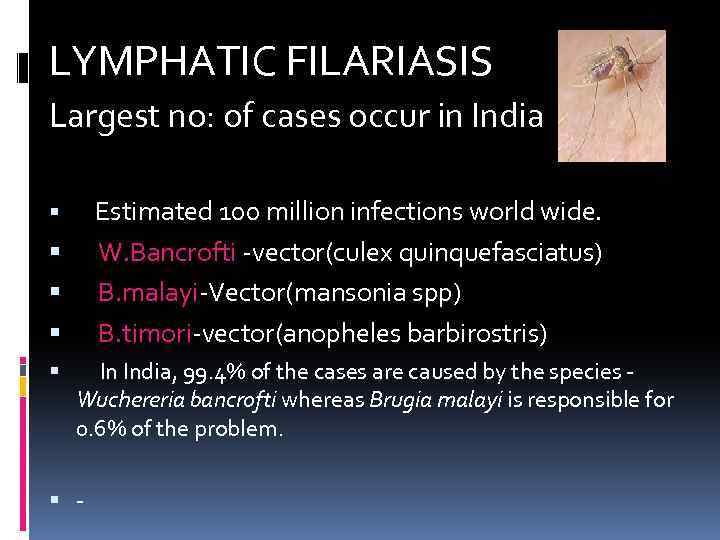 LYMPHATIC FILARIASIS Largest no: of cases occur in India Estimated 100 million infections world wide. W. Bancrofti -vector(culex quinquefasciatus) B. malayi-Vector(mansonia spp) B. timori-vector(anopheles barbirostris) In India, 99. 4% of the cases are caused by the species - Wuchereria bancrofti whereas Brugia malayi is responsible for 0. 6% of the problem. -
LYMPHATIC FILARIASIS Largest no: of cases occur in India Estimated 100 million infections world wide. W. Bancrofti -vector(culex quinquefasciatus) B. malayi-Vector(mansonia spp) B. timori-vector(anopheles barbirostris) In India, 99. 4% of the cases are caused by the species - Wuchereria bancrofti whereas Brugia malayi is responsible for 0. 6% of the problem. -
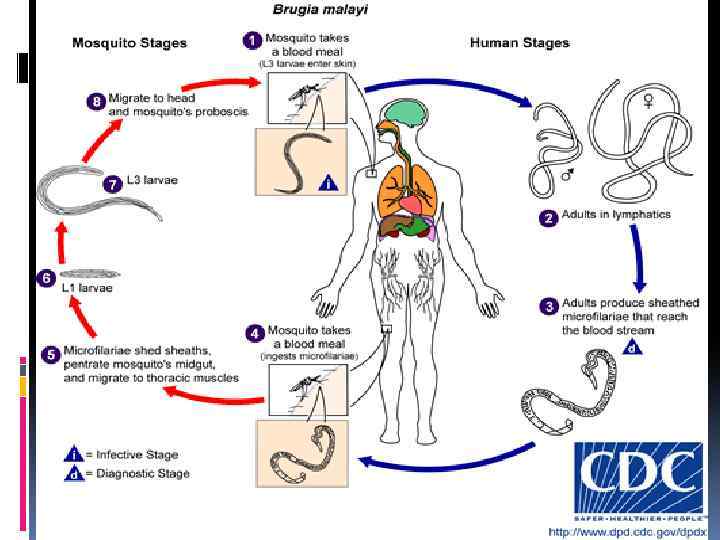
 Adults of Wuchereria bancrofti are long and threadlike. The males measure up to 40 mm long and females are 80 -100 mm long. Adults are found primarily in lymphatic vessels, less commonly in blood vessels.
Adults of Wuchereria bancrofti are long and threadlike. The males measure up to 40 mm long and females are 80 -100 mm long. Adults are found primarily in lymphatic vessels, less commonly in blood vessels.
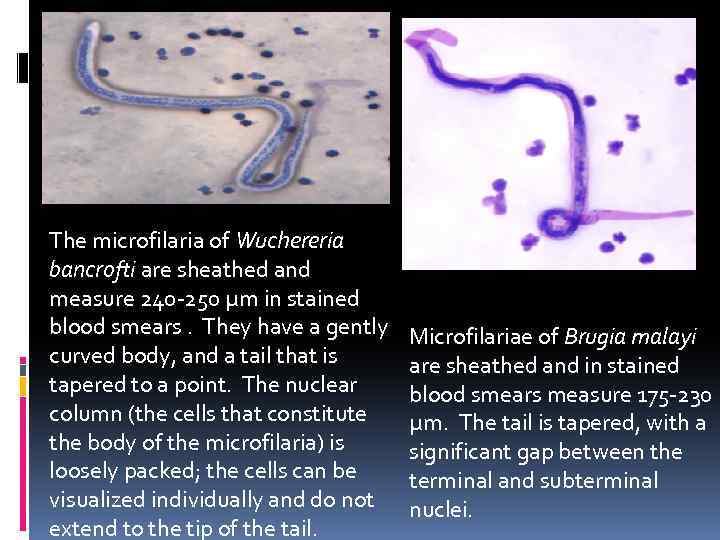 The microfilaria of Wuchereria bancrofti are sheathed and measure 240 -250 µm in stained blood smears. They have a gently curved body, and a tail that is tapered to a point. The nuclear column (the cells that constitute the body of the microfilaria) is loosely packed; the cells can be visualized individually and do not extend to the tip of the tail. Microfilariae of Brugia malayi are sheathed and in stained blood smears measure 175 -230 µm. The tail is tapered, with a significant gap between the terminal and subterminal nuclei.
The microfilaria of Wuchereria bancrofti are sheathed and measure 240 -250 µm in stained blood smears. They have a gently curved body, and a tail that is tapered to a point. The nuclear column (the cells that constitute the body of the microfilaria) is loosely packed; the cells can be visualized individually and do not extend to the tip of the tail. Microfilariae of Brugia malayi are sheathed and in stained blood smears measure 175 -230 µm. The tail is tapered, with a significant gap between the terminal and subterminal nuclei.
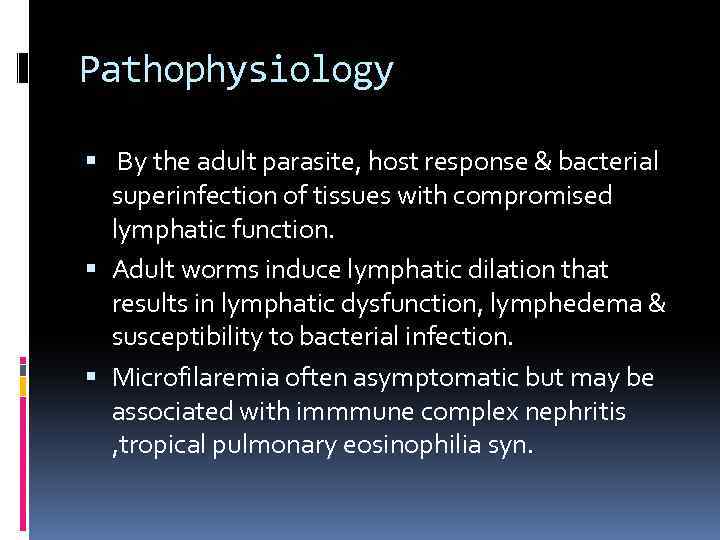 Pathophysiology By the adult parasite, host response & bacterial superinfection of tissues with compromised lymphatic function. Adult worms induce lymphatic dilation that results in lymphatic dysfunction, lymphedema & susceptibility to bacterial infection. Microfilaremia often asymptomatic but may be associated with immmune complex nephritis , tropical pulmonary eosinophilia syn.
Pathophysiology By the adult parasite, host response & bacterial superinfection of tissues with compromised lymphatic function. Adult worms induce lymphatic dilation that results in lymphatic dysfunction, lymphedema & susceptibility to bacterial infection. Microfilaremia often asymptomatic but may be associated with immmune complex nephritis , tropical pulmonary eosinophilia syn.
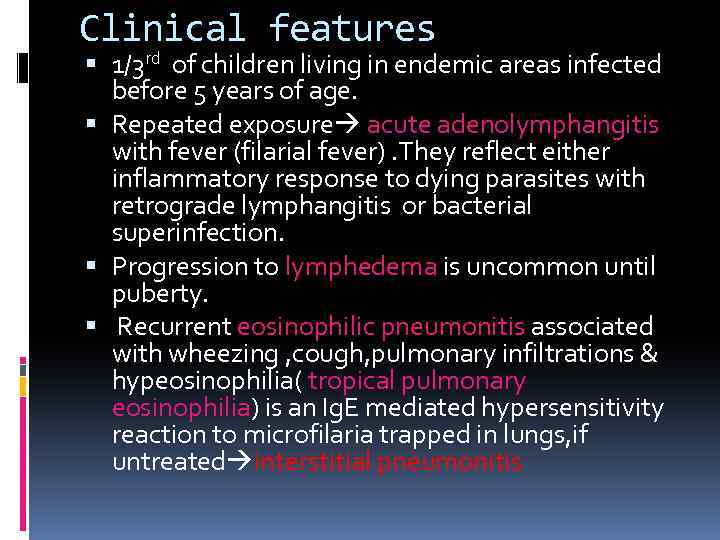 Clinical features 1/3 rd of children living in endemic areas infected before 5 years of age. Repeated exposure acute adenolymphangitis with fever (filarial fever). They reflect either inflammatory response to dying parasites with retrograde lymphangitis or bacterial superinfection. Progression to lymphedema is uncommon until puberty. Recurrent eosinophilic pneumonitis associated with wheezing , cough, pulmonary infiltrations & hypeosinophilia( tropical pulmonary eosinophilia) is an Ig. E mediated hypersensitivity reaction to microfilaria trapped in lungs, if untreated interstitial pneumonitis
Clinical features 1/3 rd of children living in endemic areas infected before 5 years of age. Repeated exposure acute adenolymphangitis with fever (filarial fever). They reflect either inflammatory response to dying parasites with retrograde lymphangitis or bacterial superinfection. Progression to lymphedema is uncommon until puberty. Recurrent eosinophilic pneumonitis associated with wheezing , cough, pulmonary infiltrations & hypeosinophilia( tropical pulmonary eosinophilia) is an Ig. E mediated hypersensitivity reaction to microfilaria trapped in lungs, if untreated interstitial pneumonitis
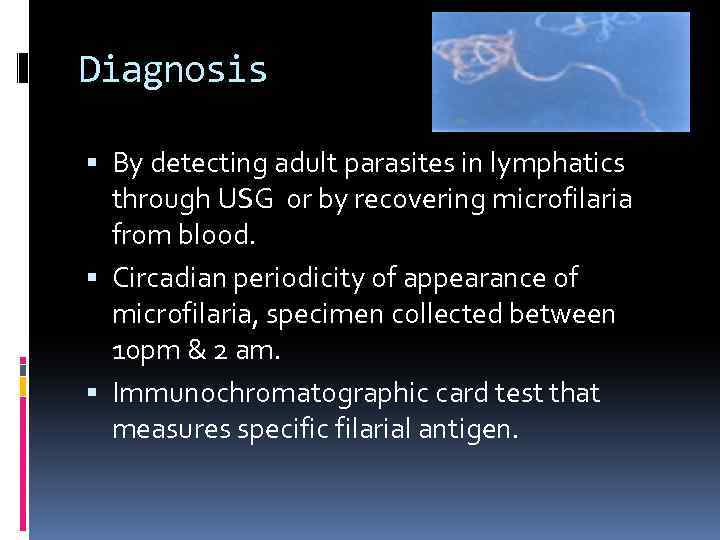 Diagnosis By detecting adult parasites in lymphatics through USG or by recovering microfilaria from blood. Circadian periodicity of appearance of microfilaria, specimen collected between 10 pm & 2 am. Immunochromatographic card test that measures specific filarial antigen.
Diagnosis By detecting adult parasites in lymphatics through USG or by recovering microfilaria from blood. Circadian periodicity of appearance of microfilaria, specimen collected between 10 pm & 2 am. Immunochromatographic card test that measures specific filarial antigen.
 Treatment Antimicrofilarial drug DEC 6 mg/kg/day, 12 day course. Side efffects due to inflammatory response to dying microfilariae symptomatic Rx. DEC also used in tropical pulmonary eosinophilia. Other drugs, Ivermectin , albendazole
Treatment Antimicrofilarial drug DEC 6 mg/kg/day, 12 day course. Side efffects due to inflammatory response to dying microfilariae symptomatic Rx. DEC also used in tropical pulmonary eosinophilia. Other drugs, Ivermectin , albendazole
 TAPEWORM-cestodes. Segmented tape like worms with size varying from few mm to several metres. Adult worm consists of 3 parts: 1) Head(scolex) carrying grooved or cup like suckers, 2) Neck, immediately behind the head is the region of growth segments of body continuuously generated. 3) Trunk, composed of chain of proglottides or segments immature, mature & gravid.
TAPEWORM-cestodes. Segmented tape like worms with size varying from few mm to several metres. Adult worm consists of 3 parts: 1) Head(scolex) carrying grooved or cup like suckers, 2) Neck, immediately behind the head is the region of growth segments of body continuuously generated. 3) Trunk, composed of chain of proglottides or segments immature, mature & gravid.
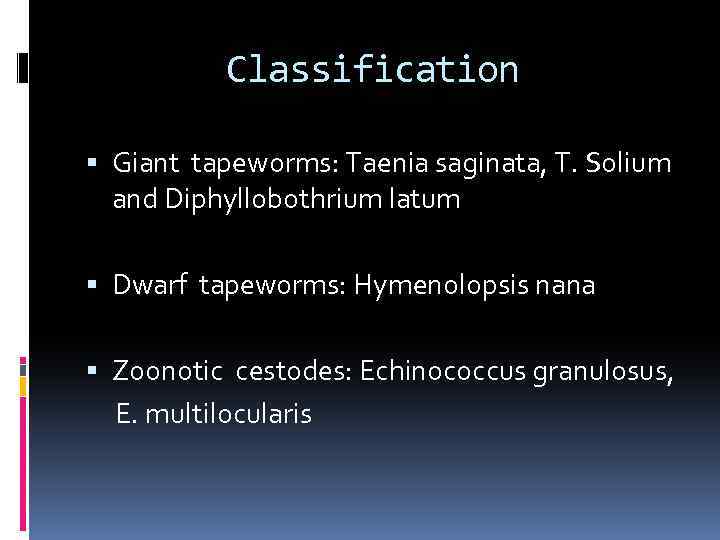 Classification Giant tapeworms: Taenia saginata, T. Solium and Diphyllobothrium latum Dwarf tapeworms: Hymenolopsis nana Zoonotic cestodes: Echinococcus granulosus, E. multilocularis
Classification Giant tapeworms: Taenia saginata, T. Solium and Diphyllobothrium latum Dwarf tapeworms: Hymenolopsis nana Zoonotic cestodes: Echinococcus granulosus, E. multilocularis
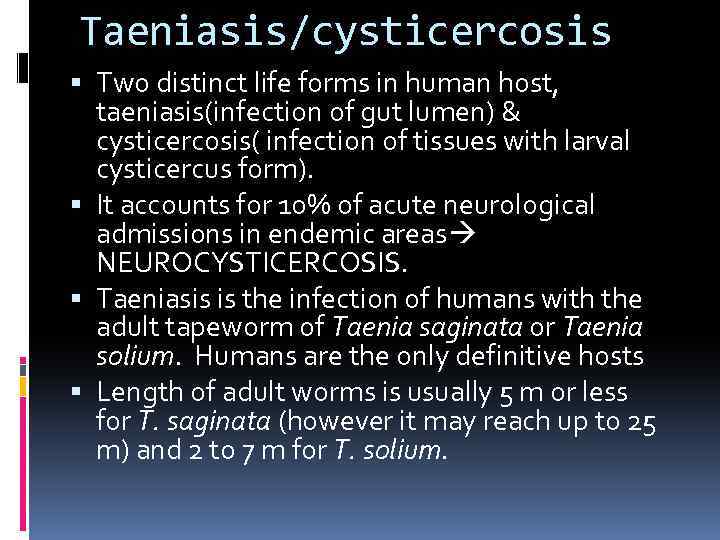 Taeniasis/cysticercosis Two distinct life forms in human host, taeniasis(infection of gut lumen) & cysticercosis( infection of tissues with larval cysticercus form). It accounts for 10% of acute neurological admissions in endemic areas NEUROCYSTICERCOSIS. Taeniasis is the infection of humans with the adult tapeworm of Taenia saginata or Taenia solium. Humans are the only definitive hosts Length of adult worms is usually 5 m or less for T. saginata (however it may reach up to 25 m) and 2 to 7 m for T. solium.
Taeniasis/cysticercosis Two distinct life forms in human host, taeniasis(infection of gut lumen) & cysticercosis( infection of tissues with larval cysticercus form). It accounts for 10% of acute neurological admissions in endemic areas NEUROCYSTICERCOSIS. Taeniasis is the infection of humans with the adult tapeworm of Taenia saginata or Taenia solium. Humans are the only definitive hosts Length of adult worms is usually 5 m or less for T. saginata (however it may reach up to 25 m) and 2 to 7 m for T. solium.
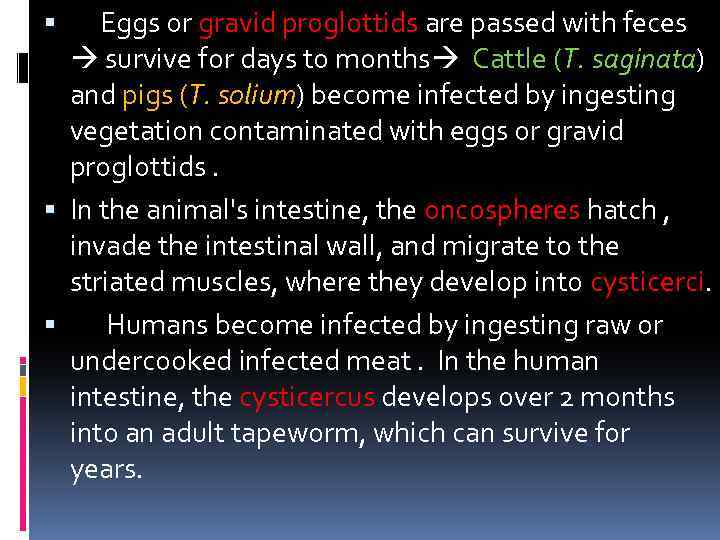 Eggs or gravid proglottids are passed with feces survive for days to months Cattle (T. saginata) and pigs (T. solium) become infected by ingesting vegetation contaminated with eggs or gravid proglottids. In the animal's intestine, the oncospheres hatch , invade the intestinal wall, and migrate to the striated muscles, where they develop into cysticerci. Humans become infected by ingesting raw or undercooked infected meat. In the human intestine, the cysticercus develops over 2 months into an adult tapeworm, which can survive for years.
Eggs or gravid proglottids are passed with feces survive for days to months Cattle (T. saginata) and pigs (T. solium) become infected by ingesting vegetation contaminated with eggs or gravid proglottids. In the animal's intestine, the oncospheres hatch , invade the intestinal wall, and migrate to the striated muscles, where they develop into cysticerci. Humans become infected by ingesting raw or undercooked infected meat. In the human intestine, the cysticercus develops over 2 months into an adult tapeworm, which can survive for years.
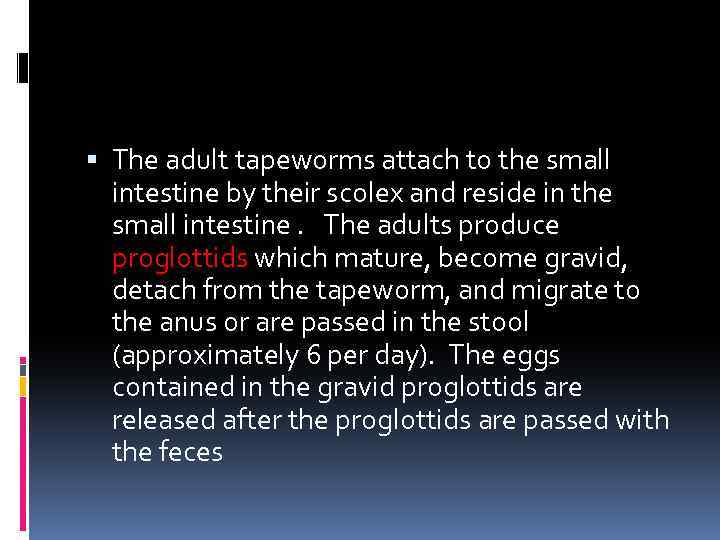 The adult tapeworms attach to the small intestine by their scolex and reside in the small intestine. The adults produce proglottids which mature, become gravid, detach from the tapeworm, and migrate to the anus or are passed in the stool (approximately 6 per day). The eggs contained in the gravid proglottids are released after the proglottids are passed with the feces
The adult tapeworms attach to the small intestine by their scolex and reside in the small intestine. The adults produce proglottids which mature, become gravid, detach from the tapeworm, and migrate to the anus or are passed in the stool (approximately 6 per day). The eggs contained in the gravid proglottids are released after the proglottids are passed with the feces

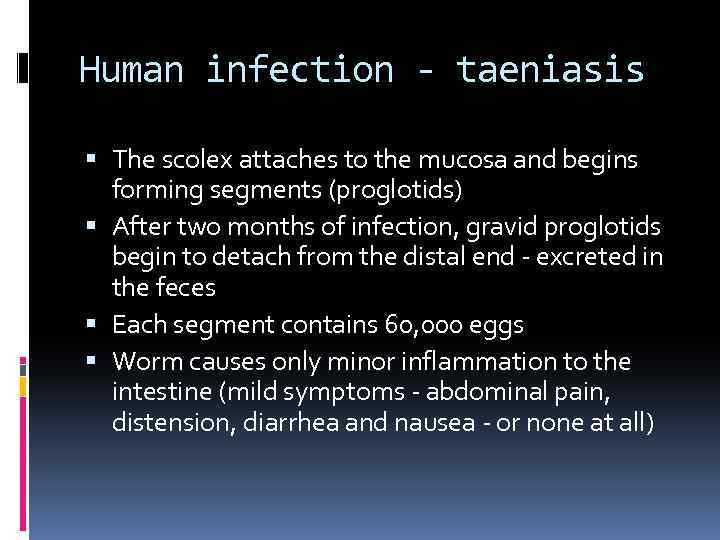 Human infection - taeniasis The scolex attaches to the mucosa and begins forming segments (proglotids) After two months of infection, gravid proglotids begin to detach from the distal end - excreted in the feces Each segment contains 60, 000 eggs Worm causes only minor inflammation to the intestine (mild symptoms - abdominal pain, distension, diarrhea and nausea - or none at all)
Human infection - taeniasis The scolex attaches to the mucosa and begins forming segments (proglotids) After two months of infection, gravid proglotids begin to detach from the distal end - excreted in the feces Each segment contains 60, 000 eggs Worm causes only minor inflammation to the intestine (mild symptoms - abdominal pain, distension, diarrhea and nausea - or none at all)
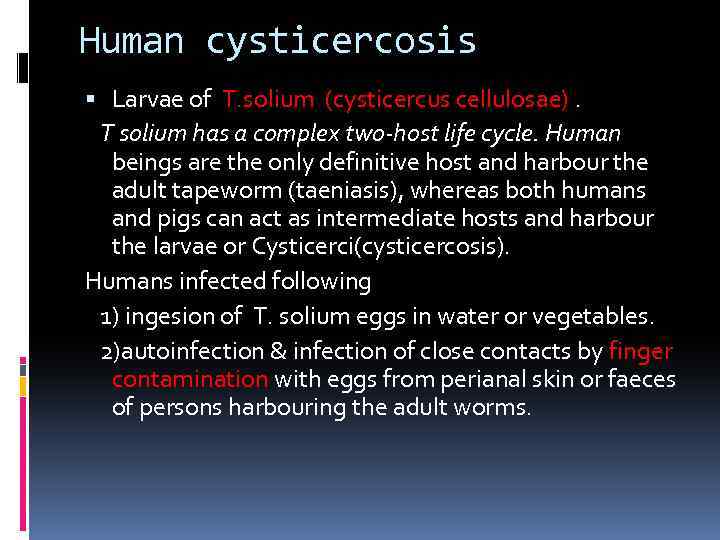 Human cysticercosis Larvae of T. solium (cysticercus cellulosae). T solium has a complex two-host life cycle. Human beings are the only definitive host and harbour the adult tapeworm (taeniasis), whereas both humans and pigs can act as intermediate hosts and harbour the larvae or Cysticerci(cysticercosis). Humans infected following 1) ingesion of T. solium eggs in water or vegetables. 2)autoinfection & infection of close contacts by finger contamination with eggs from perianal skin or faeces of persons harbouring the adult worms.
Human cysticercosis Larvae of T. solium (cysticercus cellulosae). T solium has a complex two-host life cycle. Human beings are the only definitive host and harbour the adult tapeworm (taeniasis), whereas both humans and pigs can act as intermediate hosts and harbour the larvae or Cysticerci(cysticercosis). Humans infected following 1) ingesion of T. solium eggs in water or vegetables. 2)autoinfection & infection of close contacts by finger contamination with eggs from perianal skin or faeces of persons harbouring the adult worms.
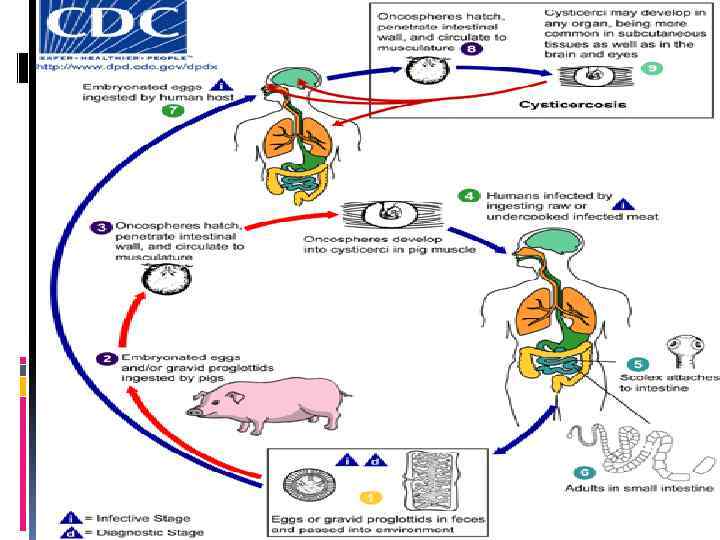
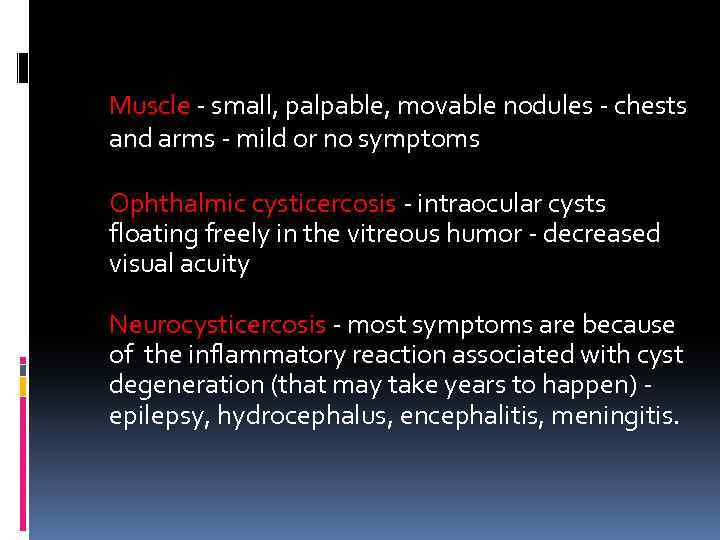 Muscle - small, palpable, movable nodules - chests and arms - mild or no symptoms Ophthalmic cysticercosis - intraocular cysts floating freely in the vitreous humor - decreased visual acuity Neurocysticercosis - most symptoms are because of the inflammatory reaction associated with cyst degeneration (that may take years to happen) - epilepsy, hydrocephalus, encephalitis, meningitis.
Muscle - small, palpable, movable nodules - chests and arms - mild or no symptoms Ophthalmic cysticercosis - intraocular cysts floating freely in the vitreous humor - decreased visual acuity Neurocysticercosis - most symptoms are because of the inflammatory reaction associated with cyst degeneration (that may take years to happen) - epilepsy, hydrocephalus, encephalitis, meningitis.
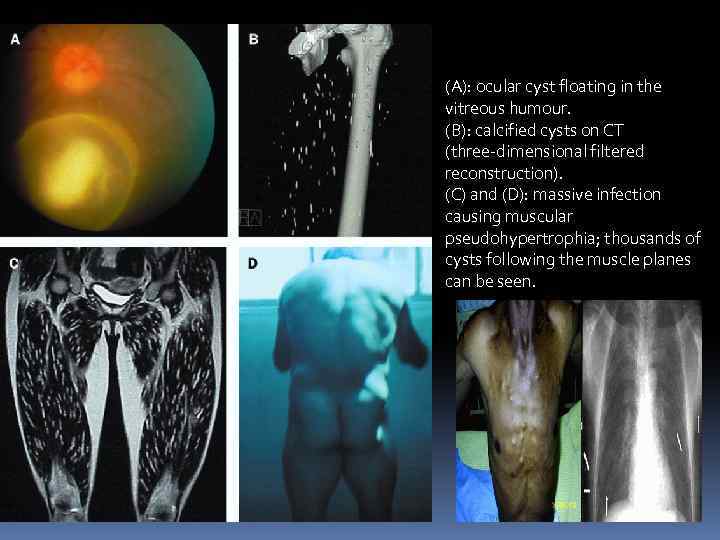 (A): ocular cyst floating in the vitreous humour. (B): calcified cysts on CT (three-dimensional filtered reconstruction). (C) and (D): massive infection causing muscular pseudohypertrophia; thousands of cysts following the muscle planes can be seen.
(A): ocular cyst floating in the vitreous humour. (B): calcified cysts on CT (three-dimensional filtered reconstruction). (C) and (D): massive infection causing muscular pseudohypertrophia; thousands of cysts following the muscle planes can be seen.
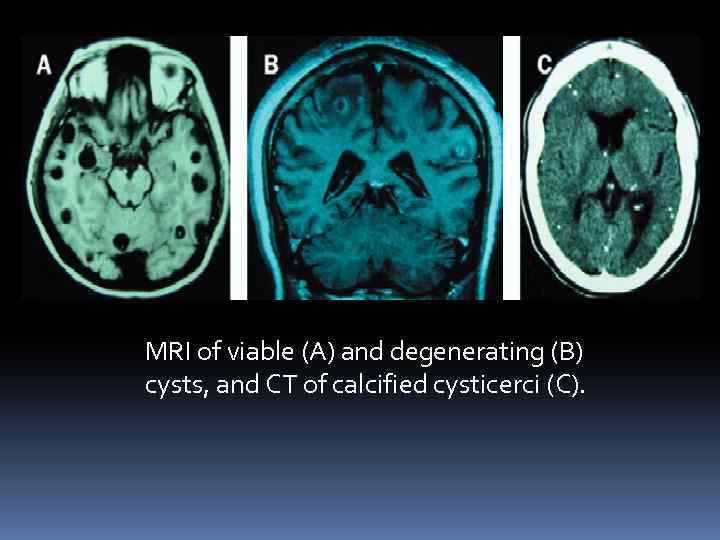 MRI of viable (A) and degenerating (B) cysts, and CT of calcified cysticerci (C).
MRI of viable (A) and degenerating (B) cysts, and CT of calcified cysticerci (C).
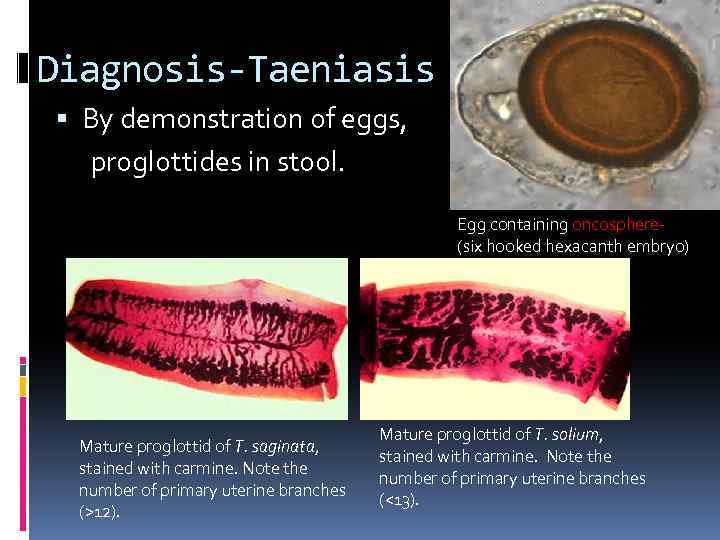 Diagnosis-Taeniasis By demonstration of eggs, proglottides in stool. Egg containing oncosphere(six hooked hexacanth embryo) Mature proglottid of T. saginata, stained with carmine. Note the number of primary uterine branches (>12). Mature proglottid of T. solium, stained with carmine. Note the number of primary uterine branches (<13).
Diagnosis-Taeniasis By demonstration of eggs, proglottides in stool. Egg containing oncosphere(six hooked hexacanth embryo) Mature proglottid of T. saginata, stained with carmine. Note the number of primary uterine branches (>12). Mature proglottid of T. solium, stained with carmine. Note the number of primary uterine branches (<13).
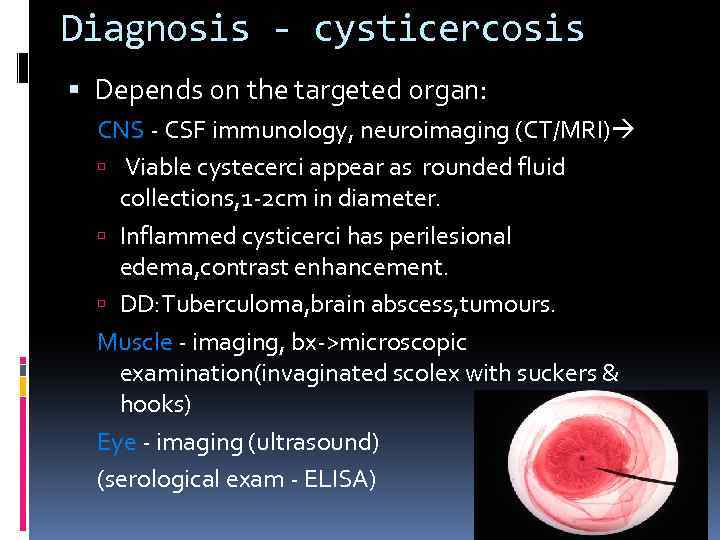 Diagnosis - cysticercosis Depends on the targeted organ: CNS - CSF immunology, neuroimaging (CT/MRI) Viable cystecerci appear as rounded fluid collections, 1 -2 cm in diameter. Inflammed cysticerci has perilesional edema, contrast enhancement. DD: Tuberculoma, brain abscess, tumours. Muscle - imaging, bx->microscopic examination(invaginated scolex with suckers & hooks) Eye - imaging (ultrasound) (serological exam - ELISA)
Diagnosis - cysticercosis Depends on the targeted organ: CNS - CSF immunology, neuroimaging (CT/MRI) Viable cystecerci appear as rounded fluid collections, 1 -2 cm in diameter. Inflammed cysticerci has perilesional edema, contrast enhancement. DD: Tuberculoma, brain abscess, tumours. Muscle - imaging, bx->microscopic examination(invaginated scolex with suckers & hooks) Eye - imaging (ultrasound) (serological exam - ELISA)
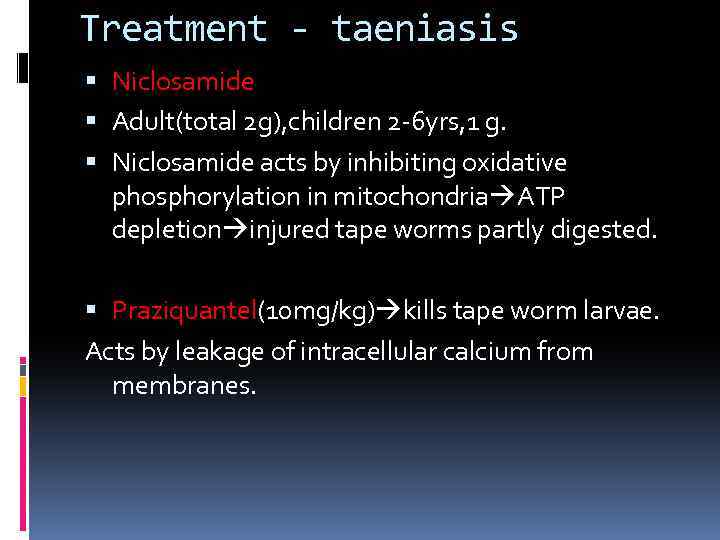 Treatment - taeniasis Niclosamide Adult(total 2 g), children 2 -6 yrs, 1 g. Niclosamide acts by inhibiting oxidative phosphorylation in mitochondria ATP depletion injured tape worms partly digested. Praziquantel(10 mg/kg) kills tape worm larvae. Acts by leakage of intracellular calcium from membranes.
Treatment - taeniasis Niclosamide Adult(total 2 g), children 2 -6 yrs, 1 g. Niclosamide acts by inhibiting oxidative phosphorylation in mitochondria ATP depletion injured tape worms partly digested. Praziquantel(10 mg/kg) kills tape worm larvae. Acts by leakage of intracellular calcium from membranes.
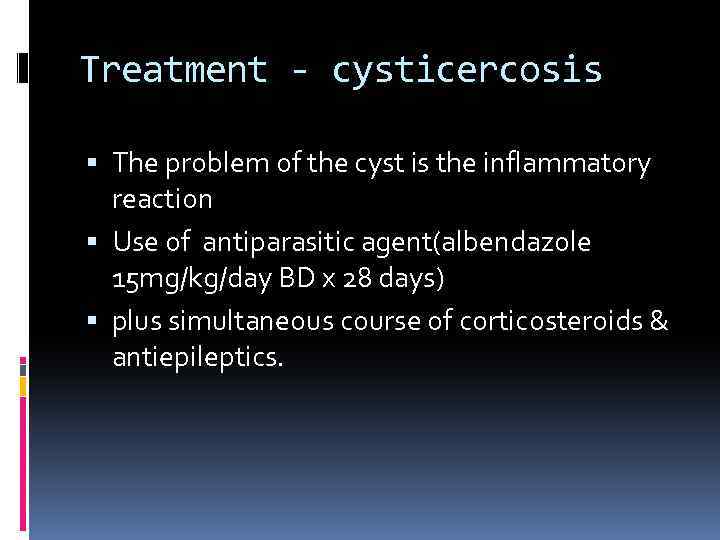 Treatment - cysticercosis The problem of the cyst is the inflammatory reaction Use of antiparasitic agent(albendazole 15 mg/kg/day BD x 28 days) plus simultaneous course of corticosteroids & antiepileptics.
Treatment - cysticercosis The problem of the cyst is the inflammatory reaction Use of antiparasitic agent(albendazole 15 mg/kg/day BD x 28 days) plus simultaneous course of corticosteroids & antiepileptics.
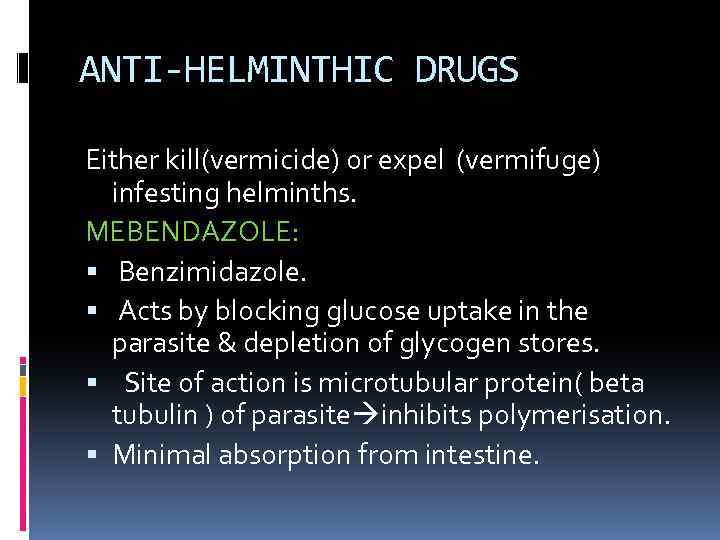 ANTI-HELMINTHIC DRUGS Either kill(vermicide) or expel (vermifuge) infesting helminths. MEBENDAZOLE: Benzimidazole. Acts by blocking glucose uptake in the parasite & depletion of glycogen stores. Site of action is microtubular protein( beta tubulin ) of parasite inhibits polymerisation. Minimal absorption from intestine.
ANTI-HELMINTHIC DRUGS Either kill(vermicide) or expel (vermifuge) infesting helminths. MEBENDAZOLE: Benzimidazole. Acts by blocking glucose uptake in the parasite & depletion of glycogen stores. Site of action is microtubular protein( beta tubulin ) of parasite inhibits polymerisation. Minimal absorption from intestine.
 Adverse effects: Diarrhoea, nausea, vomiting when used in heavy infestation. With higher doses; allergic reactions, loss of hair, granulocytopenia. Dose: Round worm, hook worm, trichuris: 100 mg BD x 3 days. Enterobius: 100 mg single dose, repeated after 2 -3 weeks.
Adverse effects: Diarrhoea, nausea, vomiting when used in heavy infestation. With higher doses; allergic reactions, loss of hair, granulocytopenia. Dose: Round worm, hook worm, trichuris: 100 mg BD x 3 days. Enterobius: 100 mg single dose, repeated after 2 -3 weeks.
 Albendazole Congener of mebendazole with advantage of single dose administration in many cases Ascaris, hookworm, enterobius, trichuris. Also in trichinosis, neurocysticercosis, hydatid disease, filariasis. Absorption after oral administration is moderate but inconsistent. Sulfoxide metabolite active against tissue helminths.
Albendazole Congener of mebendazole with advantage of single dose administration in many cases Ascaris, hookworm, enterobius, trichuris. Also in trichinosis, neurocysticercosis, hydatid disease, filariasis. Absorption after oral administration is moderate but inconsistent. Sulfoxide metabolite active against tissue helminths.
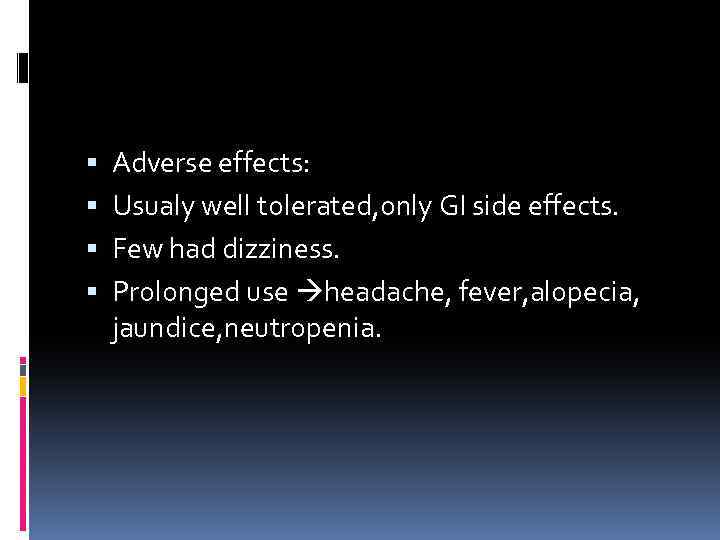 Adverse effects: Usualy well tolerated, only GI side effects. Few had dizziness. Prolonged use headache, fever, alopecia, jaundice, neutropenia.
Adverse effects: Usualy well tolerated, only GI side effects. Few had dizziness. Prolonged use headache, fever, alopecia, jaundice, neutropenia.
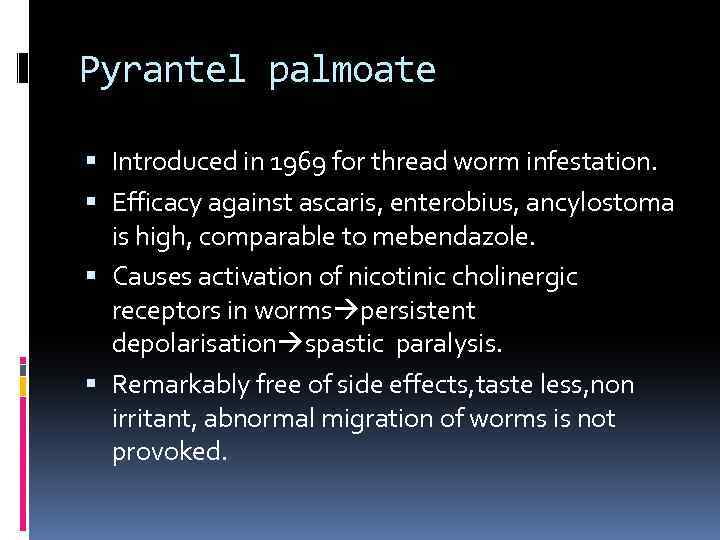 Pyrantel palmoate Introduced in 1969 for thread worm infestation. Efficacy against ascaris, enterobius, ancylostoma is high, comparable to mebendazole. Causes activation of nicotinic cholinergic receptors in worms persistent depolarisation spastic paralysis. Remarkably free of side effects, taste less, non irritant, abnormal migration of worms is not provoked.
Pyrantel palmoate Introduced in 1969 for thread worm infestation. Efficacy against ascaris, enterobius, ancylostoma is high, comparable to mebendazole. Causes activation of nicotinic cholinergic receptors in worms persistent depolarisation spastic paralysis. Remarkably free of side effects, taste less, non irritant, abnormal migration of worms is not provoked.
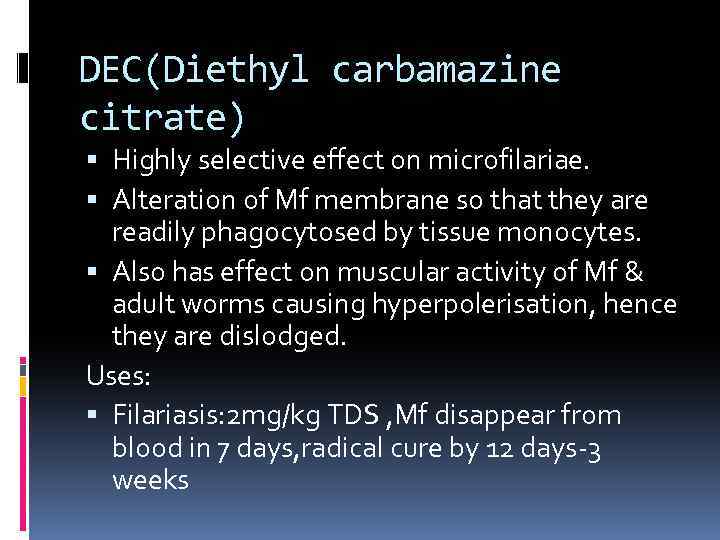 DEC(Diethyl carbamazine citrate) Highly selective effect on microfilariae. Alteration of Mf membrane so that they are readily phagocytosed by tissue monocytes. Also has effect on muscular activity of Mf & adult worms causing hyperpolerisation, hence they are dislodged. Uses: Filariasis: 2 mg/kg TDS , Mf disappear from blood in 7 days, radical cure by 12 days-3 weeks
DEC(Diethyl carbamazine citrate) Highly selective effect on microfilariae. Alteration of Mf membrane so that they are readily phagocytosed by tissue monocytes. Also has effect on muscular activity of Mf & adult worms causing hyperpolerisation, hence they are dislodged. Uses: Filariasis: 2 mg/kg TDS , Mf disappear from blood in 7 days, radical cure by 12 days-3 weeks
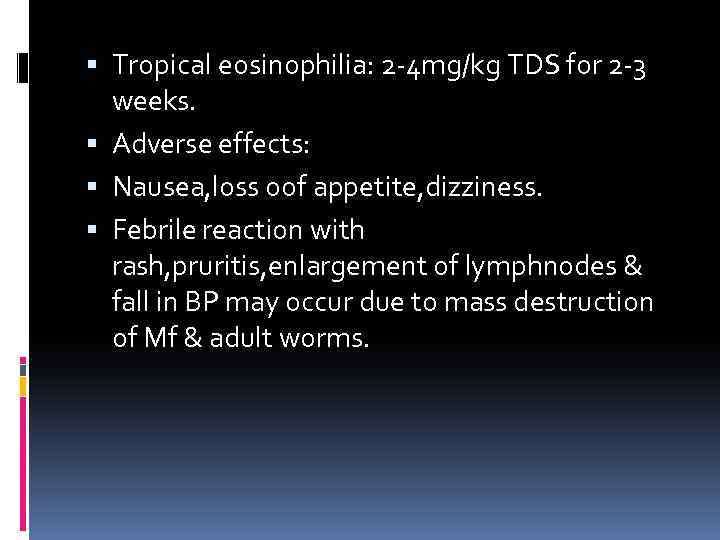 Tropical eosinophilia: 2 -4 mg/kg TDS for 2 -3 weeks. Adverse effects: Nausea, loss oof appetite, dizziness. Febrile reaction with rash, pruritis, enlargement of lymphnodes & fall in BP may occur due to mass destruction of Mf & adult worms.
Tropical eosinophilia: 2 -4 mg/kg TDS for 2 -3 weeks. Adverse effects: Nausea, loss oof appetite, dizziness. Febrile reaction with rash, pruritis, enlargement of lymphnodes & fall in BP may occur due to mass destruction of Mf & adult worms.


